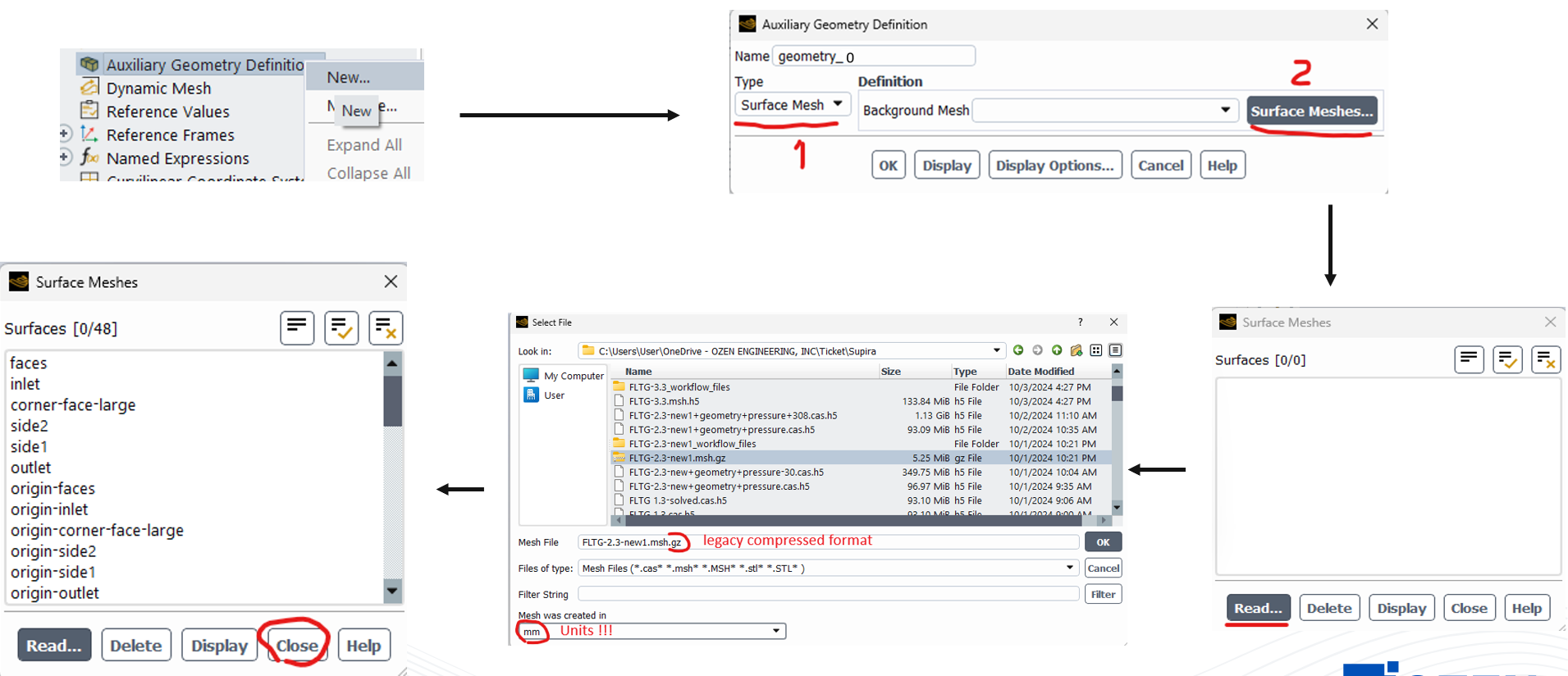Mesh Quality Issue in CFD Simulations
In CFD simulations, mesh quality directly affects analysis accuracy and efficiency. A well-constructed mesh captures physical phenomena accurately, ensuring reliable results, while poor quality can cause errors and costly design flaws. High-quality meshes are vital in complex geometries, where fluid behavior is sensitive to boundary changes. Refining the mesh in key areas balances computational cost and solution accuracy, making mesh quality essential for effective simulations.
Improve Meshing with Mesh Adaption in Ansys Fluent
In CFD analysis, selecting between adaptive mesh refinement (AMR) and static handcrafted mesh refinement greatly affects simulation accuracy and efficiency. AMR adjusts mesh density dynamically based on solution features, enabling finer resolution in critical areas and coarser meshes elsewhere. This approach enhances CFD run speed by reducing mesh density where gradients are minimal.
Ansys Fluent's adaptive meshing process begins with a coarse mesh and refines regions with high gradients using various criteria, including error estimates, solution gradients, curvature, and user-defined functions. Also, the mesh can be modified by refining or coarsening it based on Cell Registers through Manual or Automatic mesh adaptation. Additionally, Ansys Fluent offers predefined criteria tailored to applications in aerodynamics, combustion, and multiphase flow. Effectively applying these criteria is crucial for enhancing the accuracy of CFD simulations and capturing key simulation features accurately.
Setting suitable adaptation thresholds is crucial to avoid over-refinement and the associated computational expenses. Use Ansys Fluent controls to maintain a balance between detail capture and computational efficiency.
Advanced Mesh Adaption: Geometry-Based Reconstruction
For mesh adaption, starting with a quality mesh is crucial, especially in complex regions, to ensure effective adaptation. A coarse initial mesh may fail to capture flow characteristics, worsening the mesh after adaption. If the geometry includes curved profiles and sharp corners with a coarse mesh, the adapted mesh might not fully restore these features at the geometry's perimeter, as shown below for spherical geometry. During the mesh adaptation, the cross-sectional area remains constant, causing the default adaptation function to increase the cell count while the boundary still exhibits sharp corners. However, with geometry-based adaptation, the newly generated nodes are positioned in a manner that creates a finer mesh that more closely resembles the original geometry, as shown below.

Geometry-based mesh adaptation in Ansys Fluent refines the mesh around complex features like edges, corners, and curved surfaces. This advanced technique focuses on critical areas, improving mesh resolution for more accurate simulations. If geometry-based adaptation is not used with mesh adaption, the refinement can increase the cell count, but the boundary of the curved domain keeps its initial shape with the corners created by the initial mesh.
Geometry-based adaptation benefits precision industries by reconstructing or refining details. In aerospace, it enhances turbine simulations, and in automotive, it optimizes engine design, improving efficiency and reducing emissions. These examples show how advanced mesh adaption boosts CFD simulation precision and reliability.
Setup Geometry-Based Mesh Adaption
To implement geometry-based mesh adaption, follow these essential steps. Here is an overview of the process:
-
Define Auxiliary Geometry: initially generate a fine surface mesh from the same geometry using Fluent Meshing and read it as a background surface mesh in the auxiliary geometry definition in Ansys Fluent.

- Create distinct auxiliary geometry for each wall zone. It is crucial to effectively partition the outer boundaries of the domain, especially around critical areas with geometric features such as curved boundaries, and assign separate wall zones to each.
- Use auxiliary geometries for mesh adaptation through General Adaptation Control.

-
Establish additional mesh adaptations using criteria such as flow feature gradients or boundaries necessary for mesh refinement in critical areas and boundary layers at walls. The geometry-based mesh adaptation will work alongside these adaptations during the solution process. Subsequently, the initial coarse mesh will be selectively refined in the specified regions, with their shapes restored to match the original geometry.
A Case Study
The successful implementation of geometry-based mesh adaptation is illustrated in two videos featuring an example with curved boundaries and a sharp corner.
Video Part 1:
In Part 1, you'll observe mesh adaptation performance without geometry-based techniques. The demonstration covers model setup and mesh adaptation focused on wall boundary layers and pressure gradients. It aims to show how these adaptations work and evaluate their effectiveness in calculating pressure drop without relying on geometry-based methods.
Video Part 2
In Part 2, the video explains the steps for implementing geometry-based adaptation alongside other mesh adaptation methods for boundary layer and pressure gradient and how it matches the meshing on curved boundaries in this example with the original geometry.
This figure illustrates the adapted meshes at the curved cross-section of the sharp corner in this example, both with and without geometry-based adaptation.

You can watch these videos on YouTube using these links:
Mesh Adaption in Ansys Fluent-Part 1: https://www.youtube.com/watch?v=njaa_eMACDU&t=26s
Mesh Adaption in Ansys Fluent-Part 2: Geometry-Based Adaption: https://www.youtube.com/watch?v=v7yHg9h93WI
For more information on mesh adaption refinement, refer to these blogs:
1- Accelerate CFD Simulation with Adaptive Mesh Refinement: Best Practices: https://blog.ozeninc.com/resources/best-practice-for-adaptive-mesh-refinement-in-ansys-fluent
2- How to Accelerate Ansys Fluent Simulations with Adaptive Meshing: https://www.ansys.com/blog/how-to-accelerate-ansys-fluent-simulations-with-adaptive-meshing
Nov 20, 2024 5:36:56 PM
